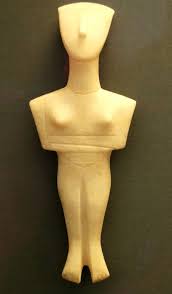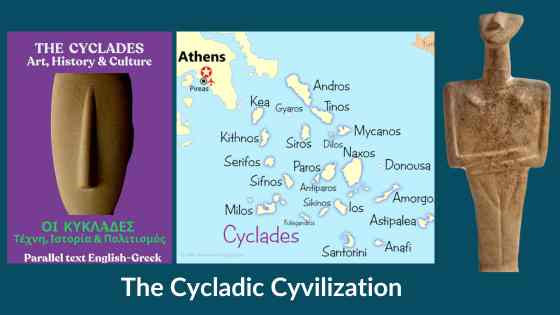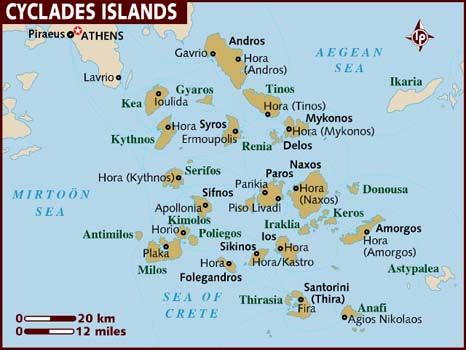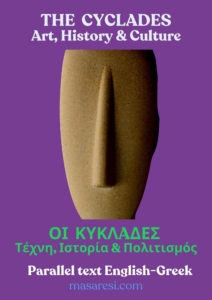The Cycladic civilization was an amazing culture, and the Greek islands of Keros and Daskalio, are actually Greece’s best prehistoric secret!
Ready to learn more? Read below in English, or click in the button for the Greek text. Also, you will find there an AUDIO link, so you can also listen to the text, while reading (Advanced level)
The Cycladic Civilization
The Mycenaean, Minoan, and Cycladic civilizations, belong to prehistory , because of the absence of writing.
So those civilizations are older than the very known “Classical Greece”, and they were flourishing in the Aegean during the Bronze Age, roughly between 3000 and 1200 BCE.
These early cultures laid the foundation for Greek art, architecture, and societal structures, which would later influence Classical Greece.
The Cycladic civilization, which thrived in the Aegean Sea during the 3rd millennium BCE, is especially renowned for its distinctive marble figurines.
These small, abstract statues have long intrigued archaeologists, and much debate exists about their purpose. Were they representations of deities? Sacred idols for rituals? Or perhaps even children’s dolls? While no consensus has been reached, one archaeological site—Keros, along with the nearby islet of Daskalio—has provided fascinating clues to the figurines’ function.
The islands: Keros and Daskalio
Keros, an uninhabited island 10 kilometers southeast of Naxos, and Daskalio, a small rocky islet off its coast, hold great significance in the history of the Cycladic civilization.
In the 1960s, renowned archaeologist Lord Colin Renfrew first visited these islands and made a remarkable discovery. On Keros, he uncovered a massive pit that had once been filled with hundreds of Cycladic figurines. Many were broken into pieces, hinting at a deliberate act rather than simple destruction.
Later excavations between 2015 and 2018, led by a team from Greece, Cyprus, and Cambridge University, revealed even more about this mysterious site.
Daskalio, once a barren rock, was found to have been home to substantial buildings some 4,500 years ago. Among the discoveries were a marble staircase, large retaining walls, and evidence of a sophisticated settlement, suggesting this tiny island played an important role in the ancient Aegean world.
The Role of Looters and Their Impact on Cycladic art
Before the scientific excavations, the islands had been looted. Ancient Greek antiquities were often stolen and sold on the black market, with figurines reaching millions of dollars at auctions. While many intact statues were taken, the broken pieces left behind were of little value to looters. These discarded fragments became vital clues for archaeologists, who began studying the site in greater detail.
Using advanced technology, including drones and 3D modeling, archaeologists uncovered even more about Daskalio. In addition to figurine fragments, they found thousands of pieces of pottery, as well as obsidian tools and rare minerals from other islands. These discoveries suggest the site was a hub for trade, with materials coming from across the Aegean. Additionally, traces of copper, a key ingredient for making bronze, were found, indicating that metalworking was also carried out here.
The Significance of Daskalio: A Religious or Trade Hub?
The discoveries on Daskalio lead to several intriguing questions. What purpose did this small, barren island serve? The elaborate marble structures and advanced features, such as a drainage system, suggest that it was not a typical settlement. Instead, it may have been a sanctuary or religious center, perhaps serving as a place of pilgrimage for people from other islands. The presence of broken figurines, many of which were deliberately shattered before being brought to Daskalio, supports this theory. Some archaeologists believe these figurines were part of ritual offerings, a form of tribute to the gods or a symbol of respect.
The island’s location also raises interesting questions about the ancient maritime network in the Aegean. To transport materials like marble from Naxos, the inhabitants of Keros and Daskalio must have been skilled sailors. Some researchers speculate that the islands were connected by a land bridge, making it easier to transport goods and people. The existence of a natural harbor on Keros, and the discovery of a grand staircase on Daskalio, supports this theory.
A maritime Civilization and Early Bronze Production
The presence of foreign materials—such as minerals from across the Cycladic islands—suggests that Keros and Daskalio were central to a larger trade network. The islands may have acted as a hub for the production and distribution of bronze, which required copper and tin. The discovery of metalworking tools and evidence of copper melting further supports the idea that Daskalio was a center for bronze production.
Additionally, archaeologists have found evidence of agriculture on the islands, with remnants of figs, olives, grapes, and other crops that likely came from more fertile regions. This suggests that people from other islands, particularly from the nearby Koufonisia islands, may have visited Keros and Daskalio for trade, religious purposes, or social gatherings.
What was the purpose of Cycladic sculptures?
 As for the Cycladic figurines, their broken forms raise further questions. Their intentional destruction suggests that the figurines may have been used in rituals. Perhaps they symbolized the people of the Cycladic islands, and breaking them was a gesture of respect, not hostility. The figurines may have been part of a larger cultural or religious practice, tied to the island’s role as a center of ritual activity.
As for the Cycladic figurines, their broken forms raise further questions. Their intentional destruction suggests that the figurines may have been used in rituals. Perhaps they symbolized the people of the Cycladic islands, and breaking them was a gesture of respect, not hostility. The figurines may have been part of a larger cultural or religious practice, tied to the island’s role as a center of ritual activity.
A Cycladic Center of Culture and Innovation
The discoveries at Keros and Daskalio shed new light on the Cycladic civilization, revealing a society that was advanced in art, architecture, trade, and metalworking. The islands were likely part of a broader maritime network that connected the Aegean world. Whether Keros and Daskalio served as religious centers, trade hubs, or both, they were clearly integral to the cultural and technological development of the Cycladic people.
Food for thought
Though we may never fully understand the exact meaning behind the Cycladic sculptures and the site itself, the excavation of Keros and Daskalio provides a fascinating glimpse into the early history of European civilization.
Cycladic culture, with its distinct art and advanced technologies, laid the foundations for many of the great civilizations that followed in the Aegean, including the Minoan and Mycenaean cultures.
The mystery of these islands, and their marble artworks is a reminder of the fascinating and enduring mystery of ancient cultures and the stories they leave behind.
++++++++++++++++++++++++++
Interested in the Cycladic civilization, the history, their art and influence on modern Greek artists?
Then this special eBook is something you would like to read.
Click here and purchase your ebook; parallel text in English and Greek





